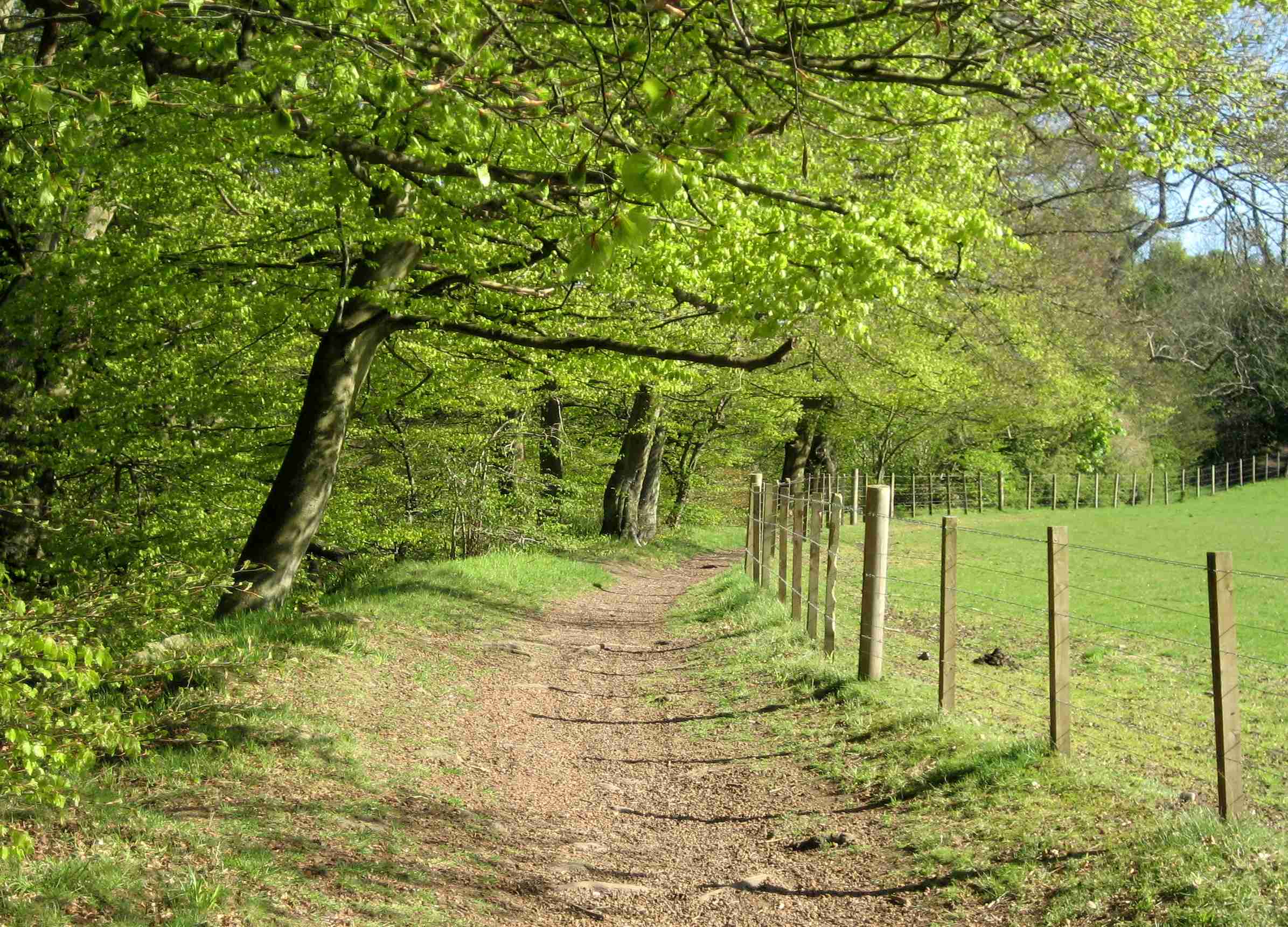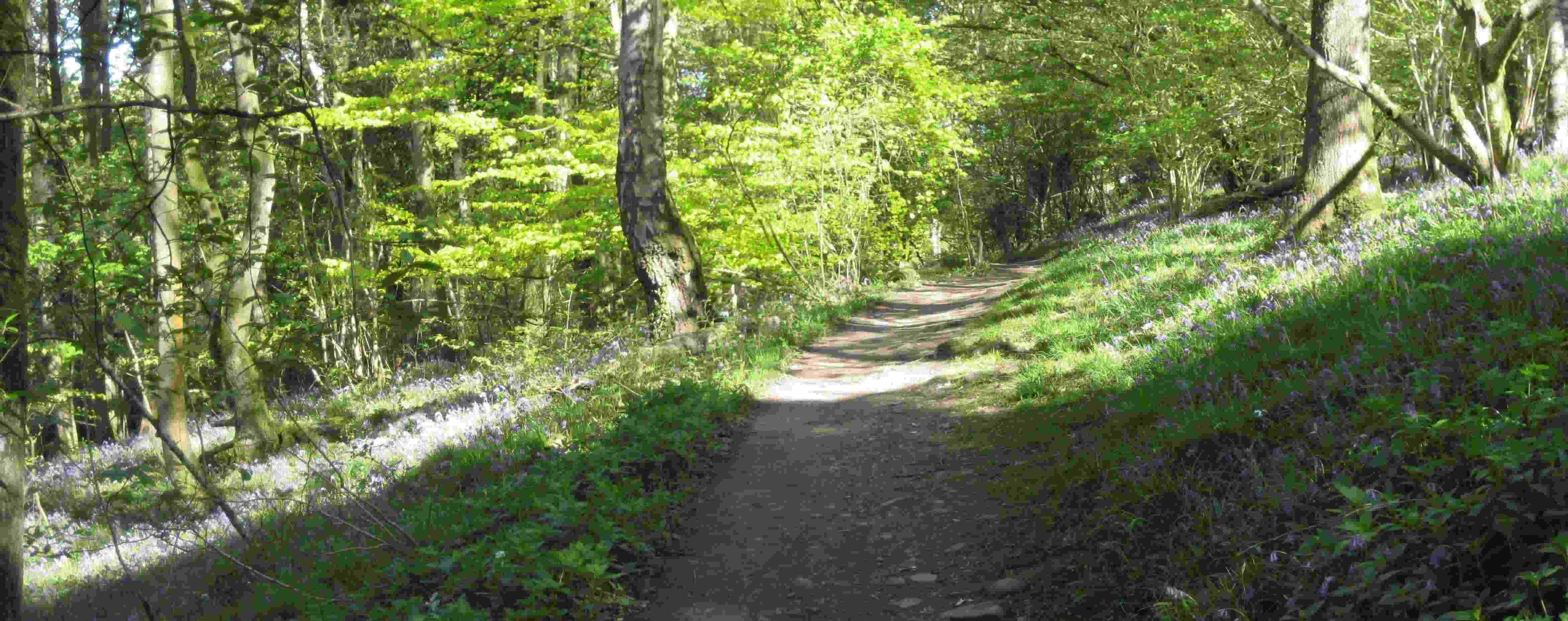| Hike Northbound through
Britain with Daryl May Click for Southbound hike |
|
 |
|
| Days N40 - N44 Central Scotland | |
|
Northbound Home Start hiking here English West Country English Midlands North of England Southern Scotland Central Scotland Scottish Highlands Southbound Home |
Tuesday, May 1, 2007
Time of departure: 7.45 am Time of arrival: 2.30 pm Place departed: Stirling, Stirling Place arrived: Braco (between Stirling and Crieff), Perth and Kinross Miles: 13 Cum miles: 666.3 Percent complete: 71.8  Braco Hotel,
Braco **** Braco Hotel,
Braco ****Cost for bed and breakfast: £30 ($60) |
| Overview of both
hikes Excerpts Statistics What others say Acknowledgments Contact me Copyright Links |
|
 |
|
| Top of page: The Darn Way near Bridge of Allan. Above: A similar scene amid bluebells | |
| I
decided to "stop and smell the roses" today, after yesterday's marathon
(for me) of 24 miles. Mind you, I needed availability of accommodation
to nudge me away from my distance-maximizing tendencies towards a
modest distance. Crieff, the next center with some accommodation
choices was 24 miles from Stirling, which seemed more of a stretch than
I could do two days running. I decided to accept any
accommodation that I could find after Braco, which is halfway to
Crieff. And find it I did, after just 13 miles and nicely
before 3 pm, right in Braco itself, at the Braco Hotel. The route, generally flat, took me first to the Bridge of Allan, a town with a bridge over a river of that name. There I stopped for a cappuccino, a civilizing gesture after last night's grubby hostel. At the next table, I met Sydney Darbon, who had buzzed in on his powered wheelchair. I suppose two lone folks meet up more easily in a coffee shop or anywhere else than do people with partners. Sydney was widowed, and not in good health – but seldom have I met a person with a finer spirit. He shared a copy of his poem, Patterns of Life, and gave me directions for the next part of my walk. From Bridge of Allan, I took a country trail next to the River Allan, called the Darn Way. It's a little known but quite beautiful, short walk up to Dunblane. Beneath oaks at first, with decaying acorns crunching underfoot, the trail visits and crosses the Allan at times, departs from it at others - and in one segment along a tributary of the Allan, it's like being in an open-air grotto, passing a cave that I hesitated to enter. One emerges from the Darn Way next to the Dunblane golf course. Dunblane is the site of Britain's worst mass murders when a gunman ran amuck at a school a few years ago. North of Dunblane the route loses its trees but gains views of distant hills; I felt I could be in Montana. The sparseness of Scotland, first evident in the southern uplands around Beattock and Crawford, was apparent here too, and would be more apparent in coming days. In more populous England, there is an irregular latticework of roads at intervals of a very few miles, and often villages at the many road crossings. Beyond that, there are well-marked trails on established public rights-of-way. This all makes it a paradise for walkers - and there is a nation of them. Scotland also attracts walkers in large numbers. But in the sparser areas, the roads are fewer and the conditions more challenging - as I was about to discover. In email that Jenny fielded for me, cousin David F asked what gave me the idea for this hike - and what preparation it took. That’s a question that others have asked, too, notably my former teacher John S. In early 1960, a Dr. Barbara Moore did this hike. The route was known then, but few attempted it, and so her hike was news. Television crews followed her, and crowds even lined the streets to cheer her on. Barbara Moore was promoting her own health regimen, which was to live on carrot juice and fresh air. Later she reckoned that the carrot juice wasn't necessary, becoming what was called a “breatharian”, though she died in a traffic accident and not from that. My recollection may be faulty, but it's the recollection that put the hike into my mind. There it stayed for 43 years or so, safely a plan and not a reality until I retired. Over the years, many have done this route on foot, many on bikes, and some on other contraptions. Two of the more interesting on-foot ones are the man who ran backwards, and the one who ran it in nine days. (Nine days is equivalent to running four Olympic marathons a day, so it will be no surprise that he had a supporting van in which he slept and that also carried his gear.) After I retired from an aerospace career in 2003, I had it in mind to do the hike now that I had time. At first home repairs, and later family matters, got in the way. When Jenny decided to go back to teaching, I moved ahead. One of the motivators was a super website by Mark Moxon, which I describe on day N4. Mark makes the hike come alive. Beyond just the route, equipment and the like, he writes humorously and speaks his mind about blisters, accommodation, and the people he met, and provides great pictures, a chat forum, and even a companion book. As well as motivating, Mark provides a lot of "how to" advice. One other thing became clear to me after reading of Mark's struggles, and that of others in their 30s - at my age, I had better get on with this. Proving to myself that I could complete this hike was my main motivation. But, for family reasons, I also needed to stride out on my own for a while. Those family reasons are an oft-repeated theme in end-to-end reports. Many people do the walk raising money for charity after the death of a loved one, like Alan Sloman as reported earlier. But others do it after a family death without thoughts of charity at all. Yet others do it in connection with a disability or illness - as, for example, Mary Laver who is currently planning to do the route in a powered wheelchair. It seems to me that the hike represents a break with the past, a fresh start, and perhaps is a cleansing ritual of sorts. On day N27, I draw attention to the hike as a metaphor for life, a line from beginning to end, and perhaps the end of the hike is a also new beginning. Madelaine Cornelius writes in Katadhin with love: an inspirational journey (Milton Books, 1997), remembering a lost son and hiking the Appalachian Trail: ". . . as in life, the trail has
a beginning and an end. Likewise the end is a new beginning".
Thus, with my own memories, I moved into the ranks of end-to-end wannabees. Next I needed to prepare. Reaching a firm decision in the fall of 2006, too late that year to do it in good weather, was a blessing in that it gave me lots of time to get ready before the next spring. There was equipment to research and buy, a lot of route and accommodation planning to do, and I needed to assure myself that I was or could become fit enough. In these planning months, I contacted lots of experts and like-minded wannabees. For brevity now, let me provide just two examples: I discussed digital maps and routes and many other things with Mark Moxon, and I shared accommodation research with Alan Sloman, who was planning his own hike, which he did in the same timeframe as me though a few weeks ahead. Meanwhile, I picked up equipment wherever I could - some on eBay, some from internet vendors, some in thrift (charity) stores, some even from yard sales. Only my boots and backpack were brand new. The dollar was sliding, and I could see lots of expenses in Britain for a protracted time. In fact, one of the reasons to average 15 miles a day was to do the walk in a reasonable time, expense-wise and in terms of time away from home. What about fitness? Well, I walk regularly, but not 15 miles a day with a 20-lb pack. I set myself the goal of achieving that distance for three consecutive days without injury. I first did lesser distances without and with a pack (loaded with books), and then did the three days with the loaded pack. It was a big effort, but it seemed successful enough. But about two weeks later, my knees gave trouble, so I rested them. When they didn’t get better, I consulted doctors. The doctors diagnosed a torn meniscus, a loose joint, and arthritis: I am sure these conditions existed, but I am also pretty sure now that they were pre-existing. When I resumed walking, my knees started to feel better. I hoped the trend would continue on the hike itself, and it did - aided I'm sure by some muscle development. There wasn't much I could do to improve my heart, which is enlarged due to high blood pressure and isn't pumping sufficiently, or my under-performing kidneys. An old back injury has arthritis in it, but I've learned after 30 years to ignore the pain as long as I'm not in spasm. A cracked left ankle about four years before the hike took a long time heeling, but none of the preparatory hiking, or the hike itself, caused it to give problems. When I left the States with Jenny - me to hike, she to visit her parents - I was well prepared, my knees being the only apparent unknown. There were doubtless lots of not-apparent unknowns, but I would just have to deal with them as they arose. After a day in London, Jenny and I went to The Volunteer near Baker Street for a drink, and then to Little Italy nearby for dinner, and next morning I headed for Land's End and the adventure that lay ahead. |
|
| Day N40 © 2007 and 2008 Daryl May Day N42 | |